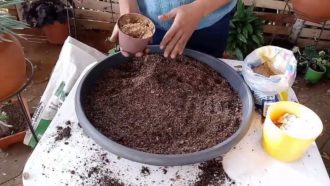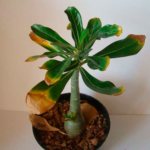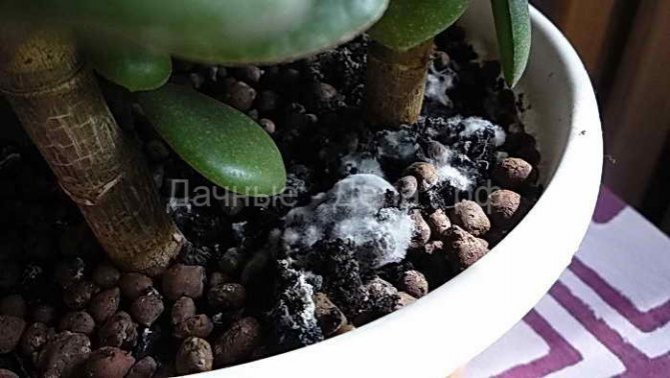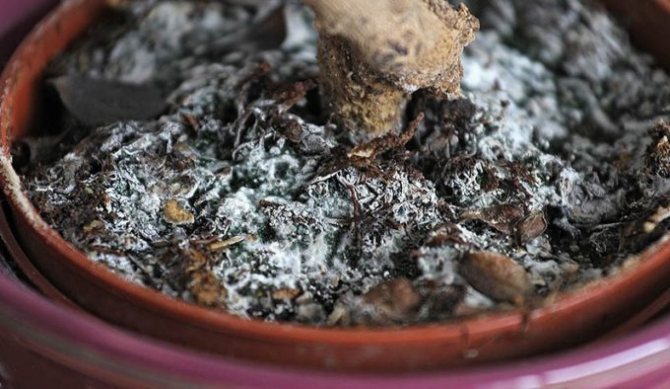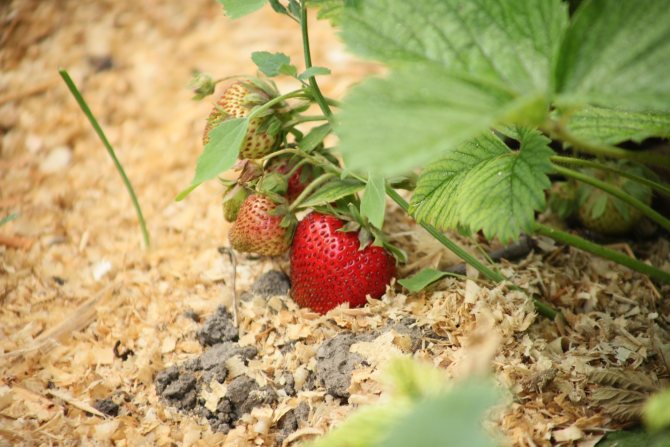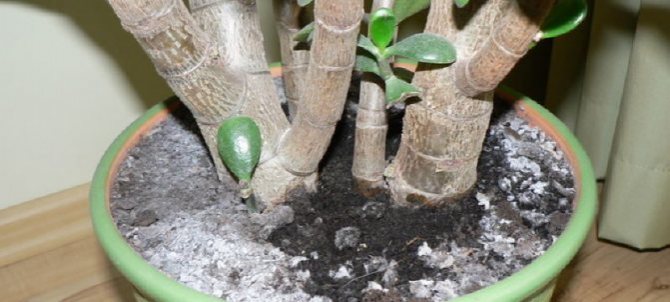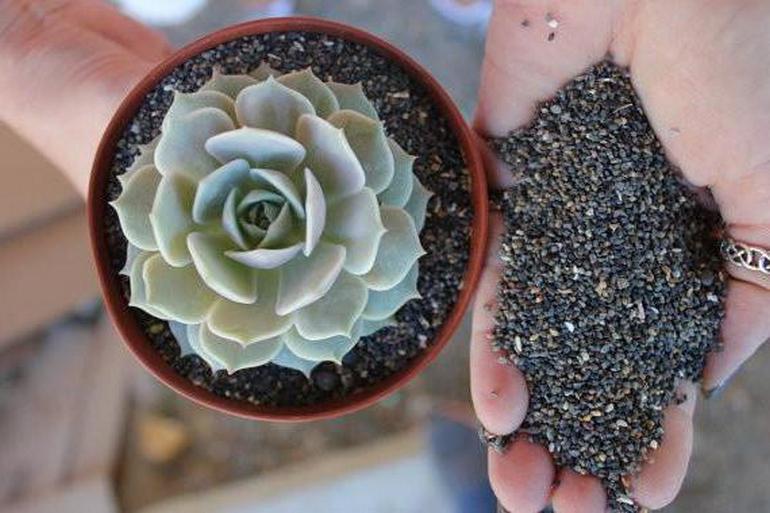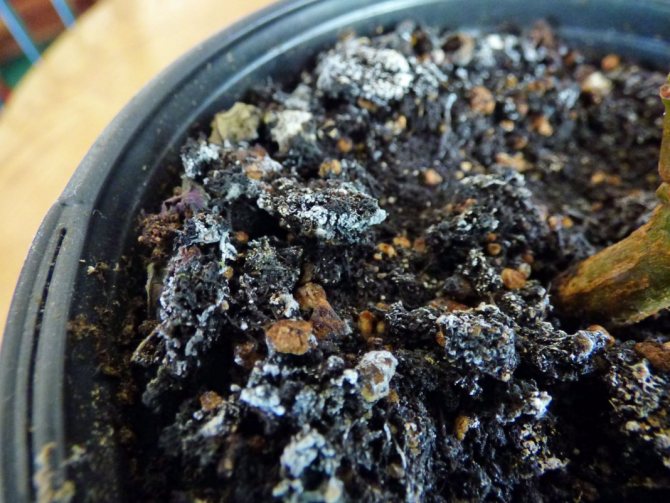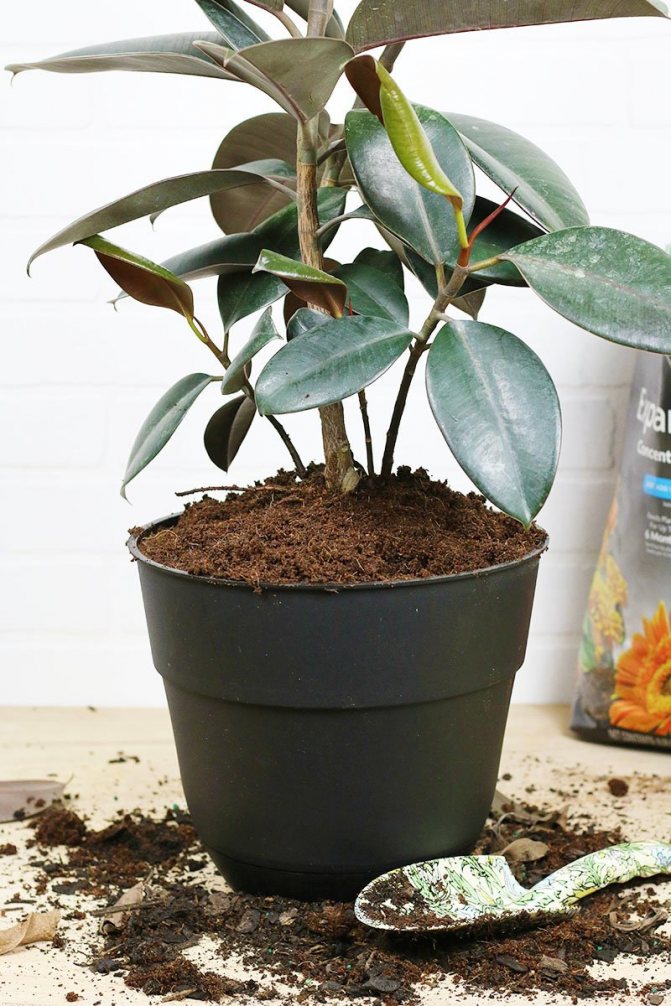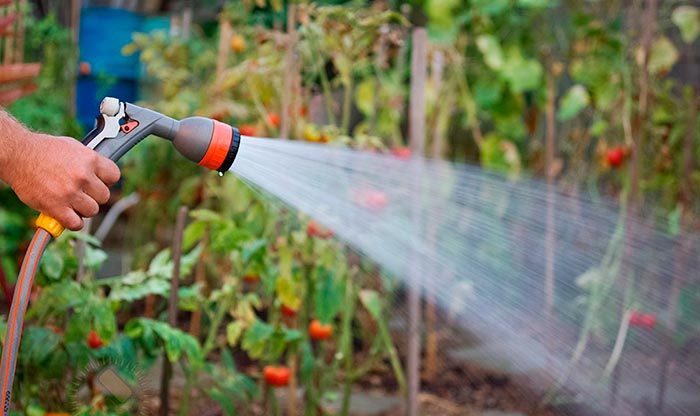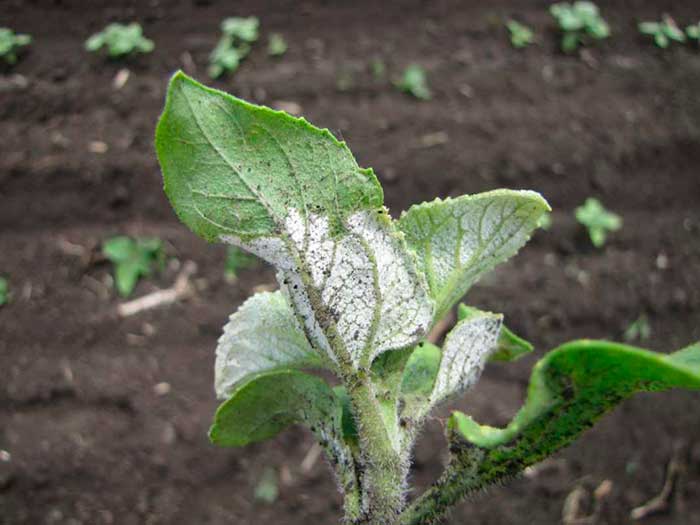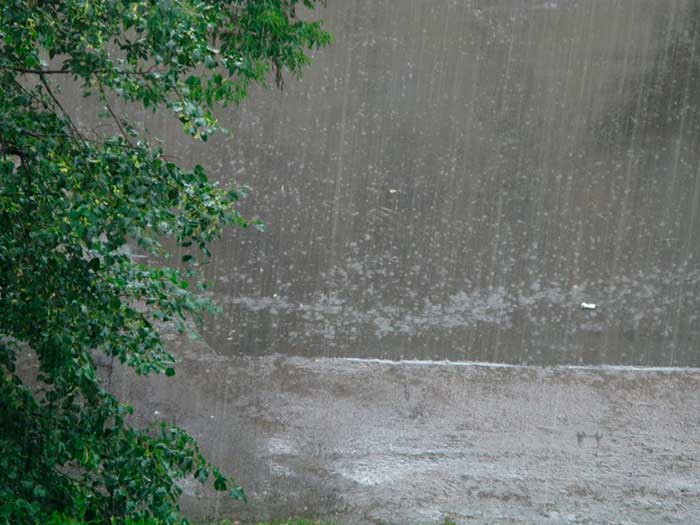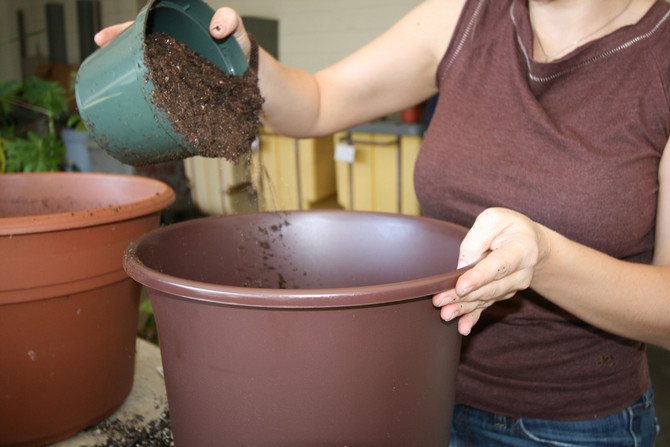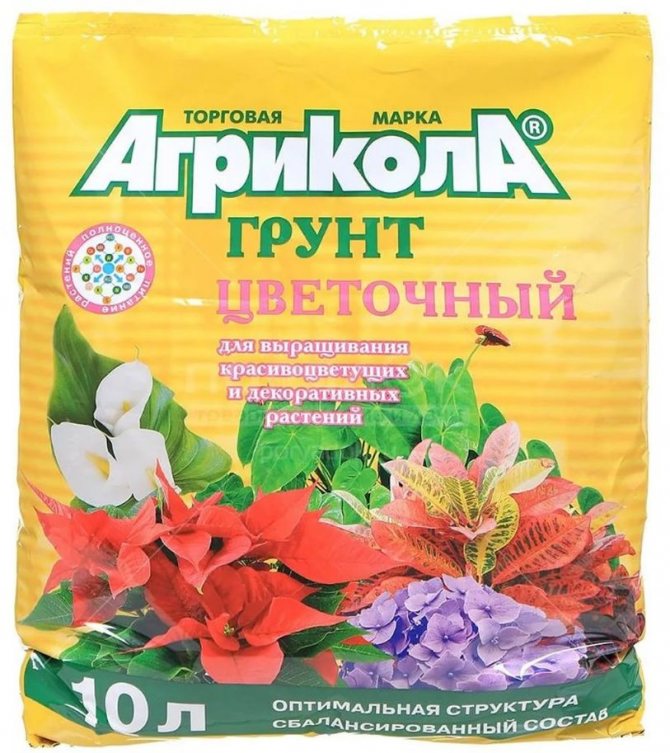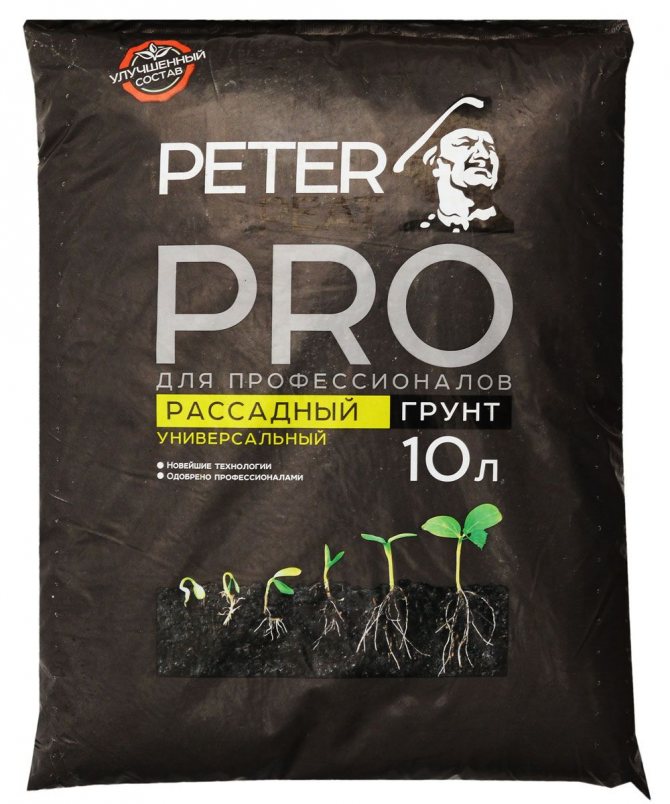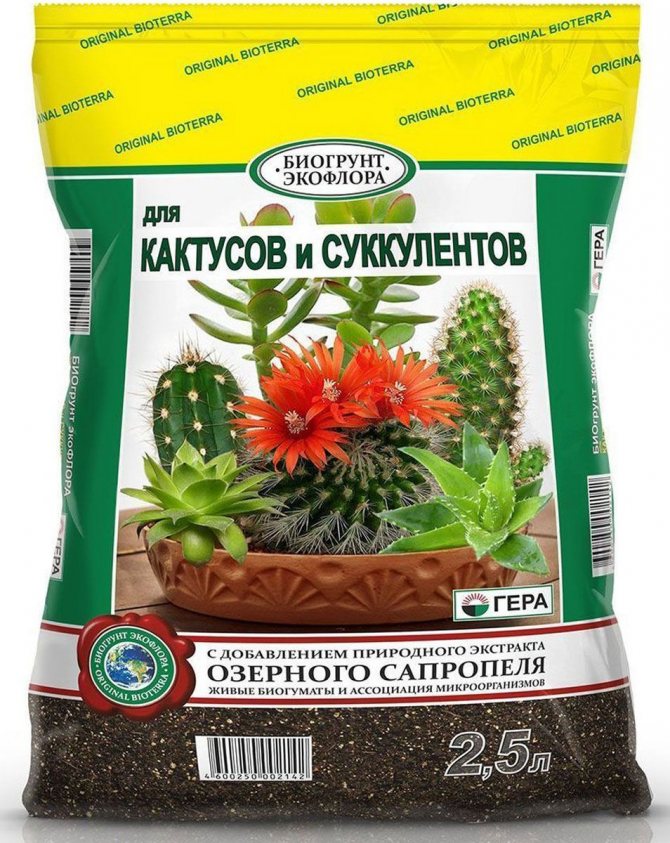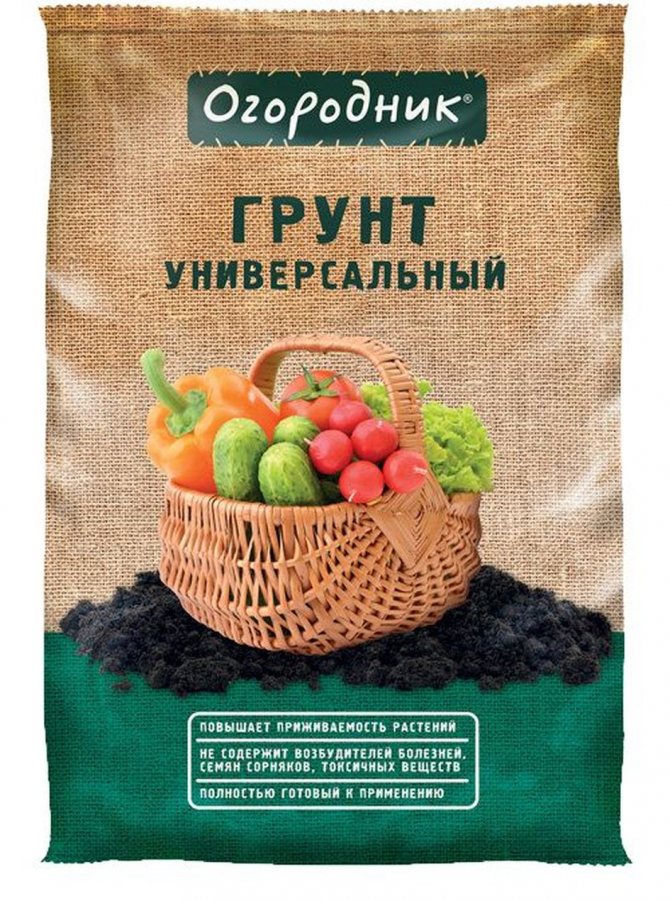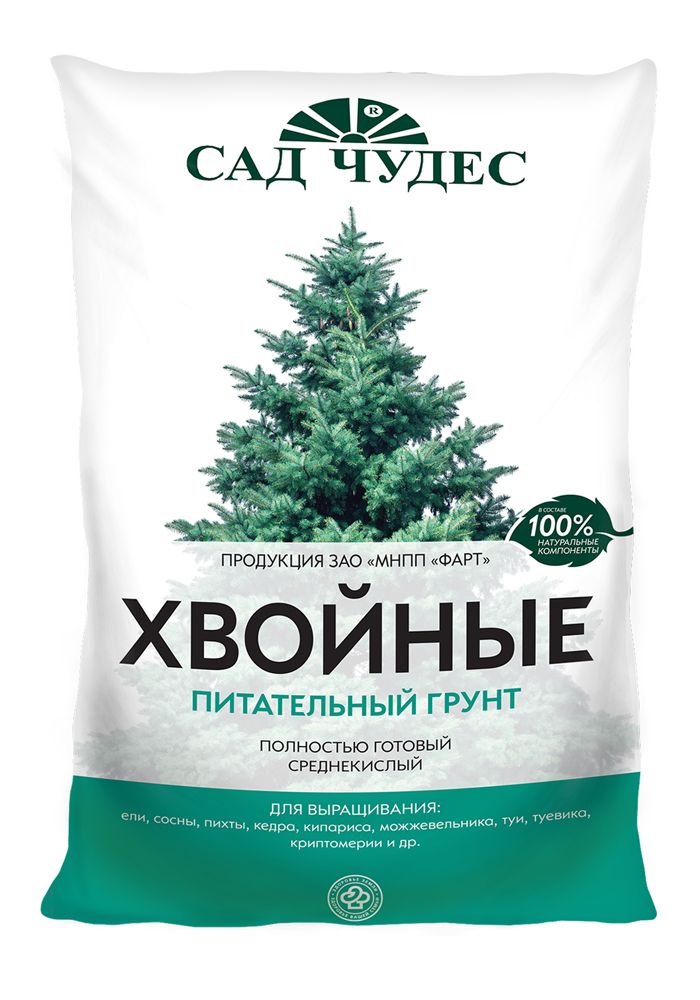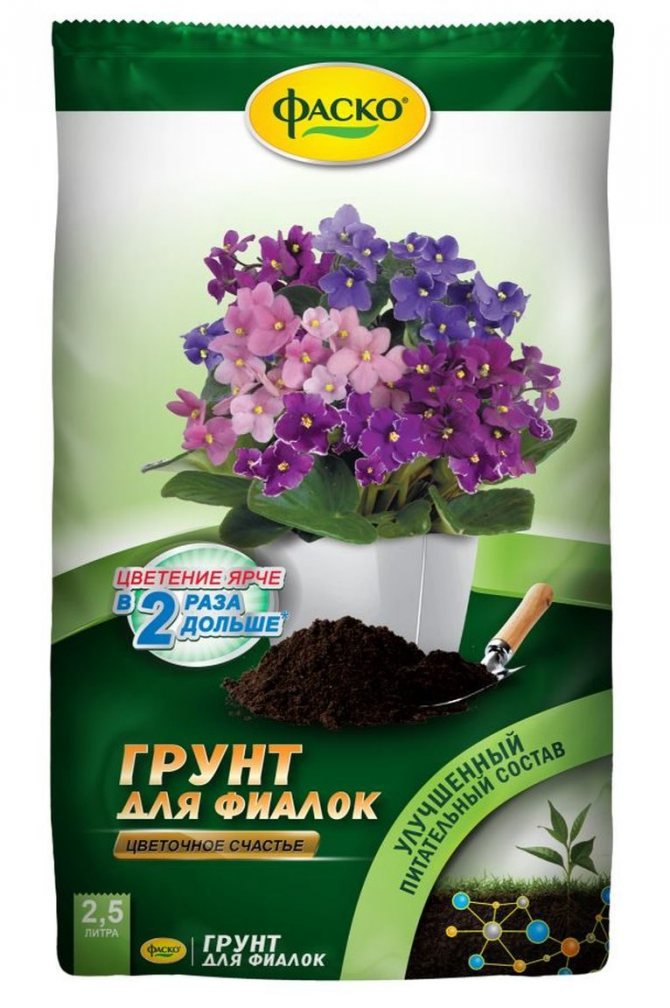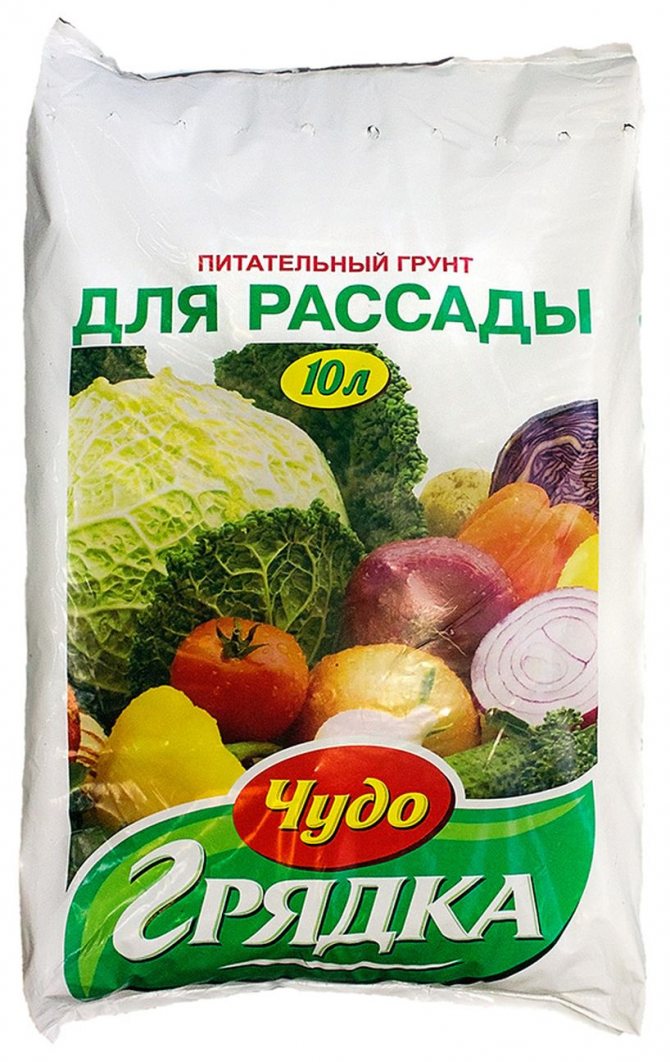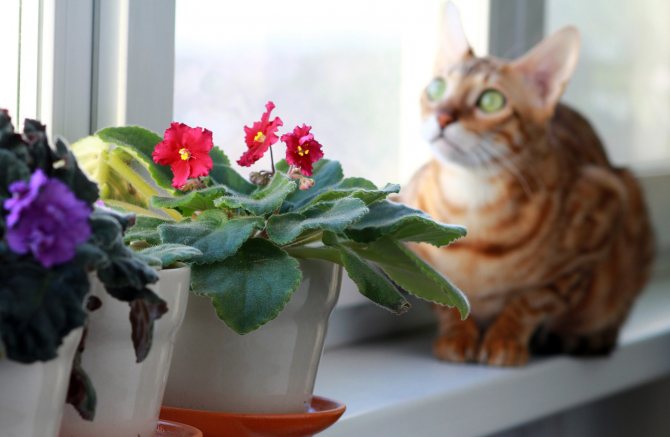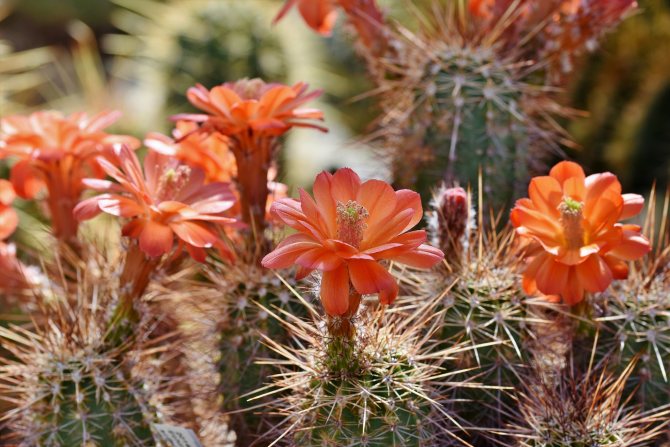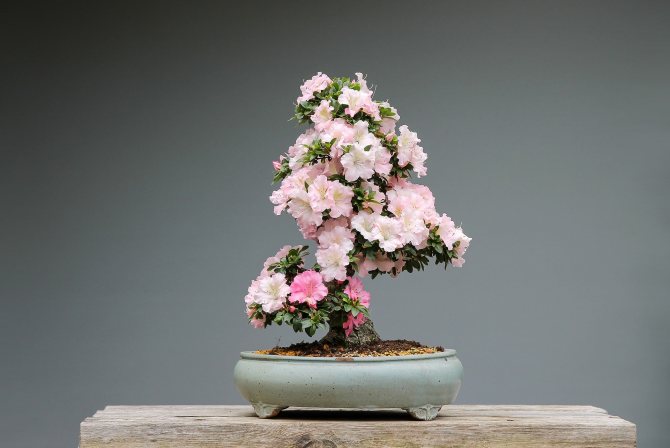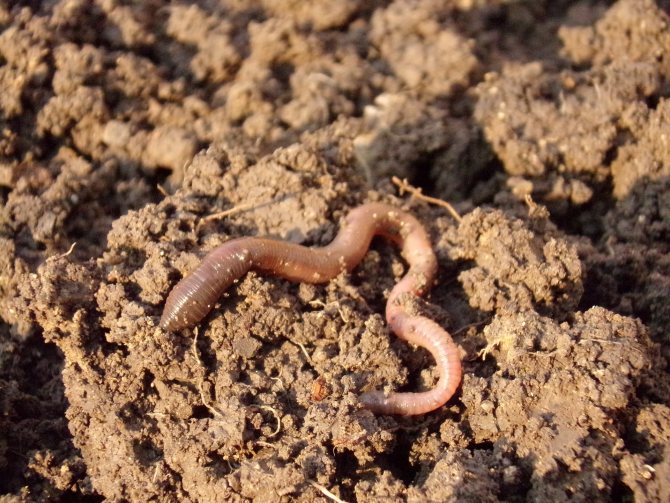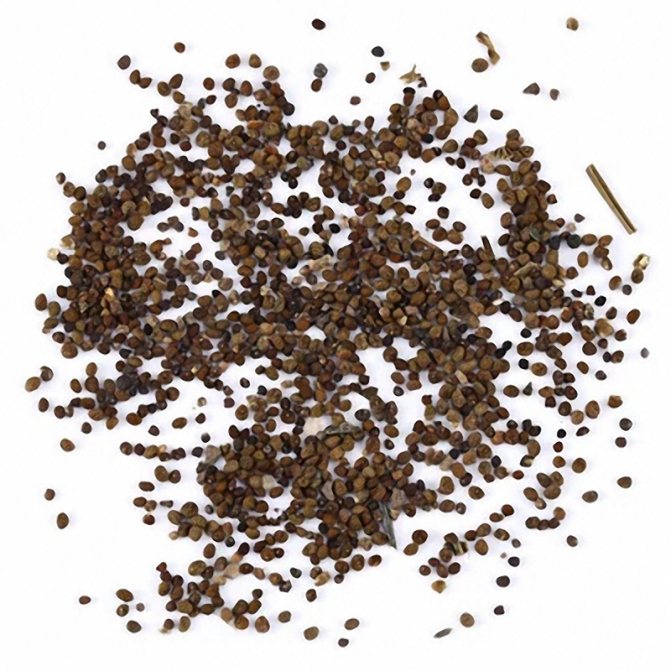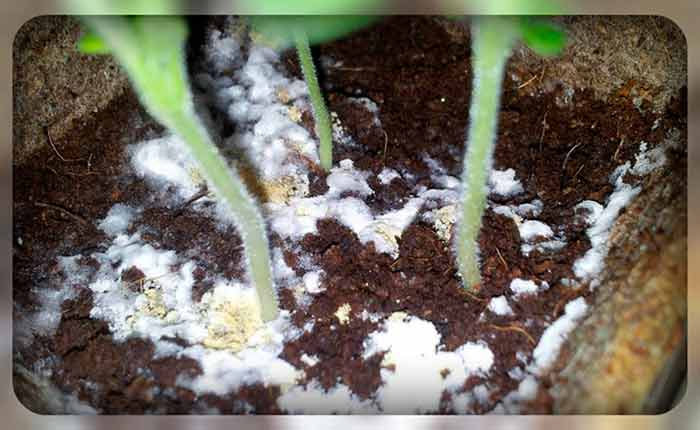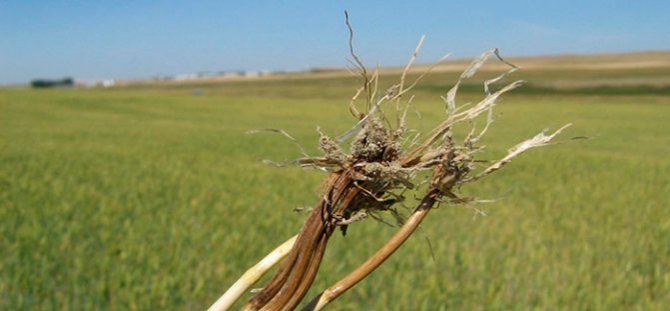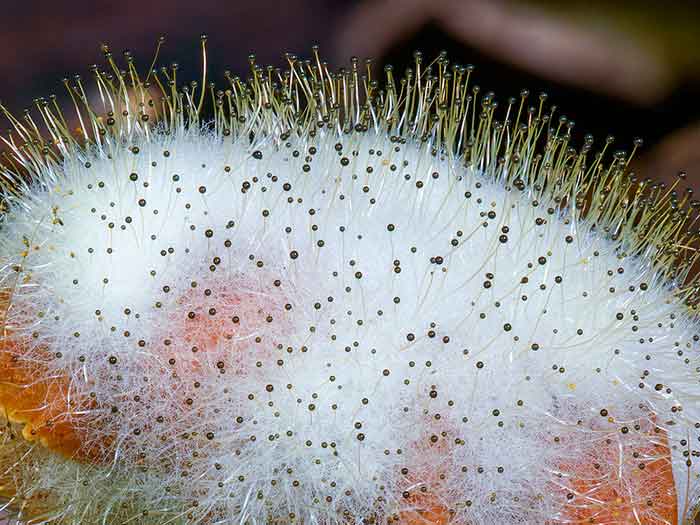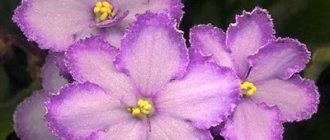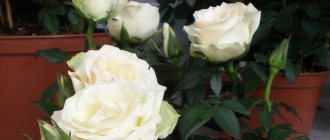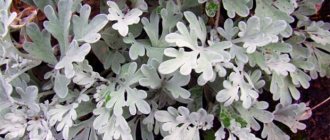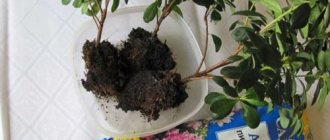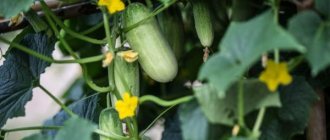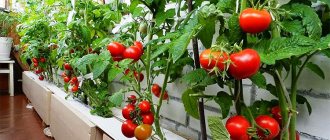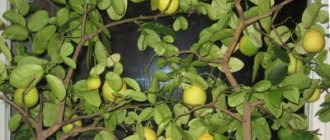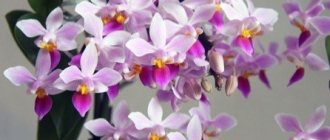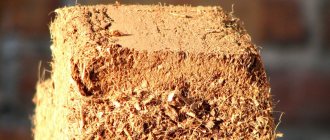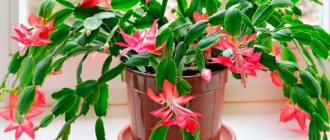On cold winter days, the blossoming Decembrists delight their owners with bright lights of flowers. This is probably why zygocactus (Decembrist, Christmas, Schlumberger) is one of the most popular plants among flower growers, and also due to its unpretentious care.
However, few know that Schlumberger is quite demanding on the composition of the soilin which it grows. If a florist approaches the issue of preparing the substrate irresponsibly, then the zygocactus is unlikely to please him with lush and long flowering.
What kind of soil is needed for the Decembrist? How to cook it? This article will try to answer these questions.
Problems with the soil in the flower pot
If the soil in a flower pot or in the garden has been flooded, then emergency measures must be taken to save the flower. How to save a flooded flower in the country? The first step is to remove the flower from the pot and leave it to dry for several hours. It is advisable to plant the flower in new soil, but if necessary, you can save the old soil by reusing it. To do this, it must be treated with antibacterial solutions and steamed in a microwave oven for 15 minutes. After that, the soil is well dried and used for planting.
If the soil in the flower pot has not yet become covered with green mold, then the symptoms of waterlogging are eliminated quite easily. A little clay, sand or wood ash is poured on top of the soil, which will absorb excess moisture. You can also loosen the soil with a wooden stick and make deep punctures in it, which eliminate excess moisture. The easiest way to dry the soil is to line the potted soil with regular paper towels. It is very important to check the drainage holes of the planting tank if problems arise with the soil. After all, they can be clogged, which is why the soil in the flower pot is constantly wet and does not dry out. How to make a planter for flowers with your own hands, you can find out here.
Plaque on the surface
If the soil in the flower pot receives an excess of water, then a white or yellow bloom appears on the surface of the soil. The main reason for this is watering with very hard water. Because of this, a calcareous sediment forms on the surface of the soil, and it turns white. This problem is resolved in several ways. The first thing to start with is to exclude watering flowers with water directly from the tap. It should stand for one day. You can also add citric acid to the water. For one liter of water, half a teaspoon of the substance, thanks to this, it is possible to neutralize lime compounds.
In addition, to prevent the formation of white bloom, the soil is covered with expanded clay, which absorbs excess moisture. And you can also sprinkle the soil in the pot with coarse river sand, which is loosened along with the earth. Such activities have a beneficial effect on the health of the flower roots. The next way to remove excess moisture is to remove the top layer of soil and add dry, leafy soil to the pot. The surest and easiest way to remove plaque on the ground is to install a water filter in your home that will soften hard water.To soften the water, cloth bags with peat are dipped into it.
The consequences of a wrong choice
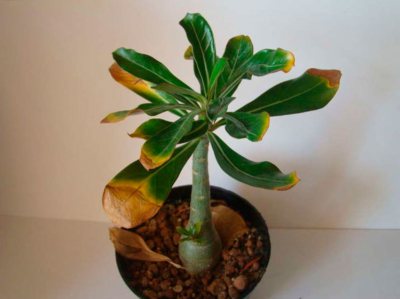
- Strong acidity of the soil or, conversely, an alkaline environment leads to tree disease (you can learn about possible problems, diseases and pests of adenium here, and from this article you will learn about the causes of desert rose diseases and methods of treatment). The plant cannot absorb nutrients and trace elements and stops developing.
- In moist and dense soil, the tree begins to rot, conditions favor the development of harmful microorganisms.
- Excessive nutritional value of the soil leads to lush foliage growth, with little or no flowering.
Adenium is an unusually beautiful plant that pleases with its flowering for a long time. The main condition for this is the choice of quality soil. Whether you buy the substrate in the store or cook it yourself, compliance with all the requirements for its composition will give you the opportunity to enjoy the view of a flowering plant all year round.
If you find an error, please select a piece of text and press Ctrl + Enter.
Traditional methods of treating white plaque
There are also folk remedies for fighting mold on the ground, but they are effective only at the very beginning of the disease.
- after planting the plant, sprinkle the ground with sand or expanded clay;
- if the appearance of mold has already begun, transplant the plant to another land, and on top put a few cloves of garlic until completely dry, then replace them with new ones;
- when a white bloom appears, remove the top layer of the earth, pour in a fresh one, and put 5-6 tablets of activated carbon on top of the soil;
- a solution of citric acid will help get rid of mold, per liter jar of 0.5 teaspoon. Only those plants that accept acidic soil can be watered with it.
Prevention when preparing components for the potting mix
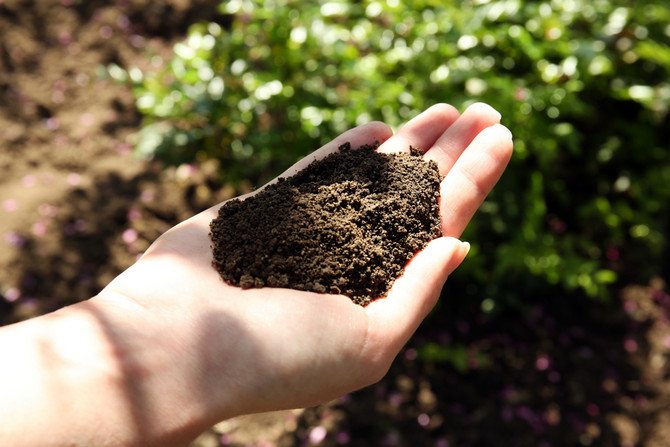

When preparing components for the potting mix, you have to collect the soil in different places: in the forest, in the meadow, in the field and on the river bank. Naturally, such a land contains a large number of various insects and their larvae, fungal spores that can cause fungal diseases. So that there are no problems in the future when growing plants, it is necessary to prepare such soil before use. It is recommended to carry out mandatory heat treatment in the form of steaming.
Choose a large container, pour a small layer of well-moistened sand (about 3-4 centimeters) on the bottom, and all the components of the future soil mixture on top. Put the container on a low heat for heating and steaming. When heated, wet sand will give off steam, which will gradually warm up the rest of the mixture. It will take about one hour to warm up a ten-liter container.
There is one significant drawback in such processing - it is one hundred percent death of beneficial microorganisms, which are vital for the growth and development of plants. No organic food can be absorbed by plants without them. It will take some time and patience to fix this problem. When at least 30 days have passed after planting an indoor flower, you can begin to populate the soil with new useful "tenants".
The saturation of the soil with important microorganisms must be carried out gradually and try to maintain their number. Live microorganisms are found in many special preparations and organic feedings. Specialized shops for gardeners and florists offer for these purposes to use the means "Ecostyle", "Baikal", "Vostok EM-1" and "Vozrozhdenie".
As a disinfecting procedure for the soil, you can try freezing or processing with chemicals. Chemicals will kill all harmful bacteria and fungal spores and get rid of infectious diseases. And after freezing the soil, its structure even improves.
Why do animals eat and dig the ground?
Usually young Alabai puppies and kittens, who are just mastering the new world and trying to taste everything, dig or eat earth, grass, coal. How to wean a puppy or a child if he climbs and rakes the soil? The animals are driven by the usual curiosity, so after several attempts to eat the earth, everything stops. A toy terrier puppy will understand that the earth is not tasty and will not try it again. However, this symptom is not curiosity, but the reason for the psychological state of the dog or cat. This happens due to the fact that the animal does not feel comfortable in the house or has dislike for a new family member.
Perhaps the owner treats the cat or dog badly, punishes him, and he takes revenge in this way. Sometimes animals gnaw and tear off furniture, walls or shoes of their owner. Therefore, in order to understand why an animal licks clay and sand, digs or eats soil from a flower pot, it is necessary to examine its health, for example, for cat anemia. If the reasons lie in the personal enmity of the animal or in psychological discomfort, then the owner and his household should give the pet more affection. It is very important to communicate more with the pet, give it time, praise it, play with the animal.
Fungal infection
Sometimes plaque in a pot appears due to a fungus that has settled in the soil. Plaque in this case is more like a whitish fluff or mold, and the smell of rot will come from the ground. Most often, the appearance of a fungus is caused by excessive moisture in the soil, keeping the flower in inappropriate conditions.
Suitable conditions for the growth of the fungus are air humidity reaching 85-90% and a warm temperature of + 20-25 degrees. Stagnant, unventilated air, a minimum amount of sunlight also contribute to the appearance of mold with fungus in flower pots. Note that the fungus is fatal to the plant: if measures are not taken in time, the flower may die.
Measures need to be taken urgent and radical: a simple replacement of the top layer of the earth is not enough here. It is necessary to get the flower out of the pot, rinse its roots, treat it with a disinfectant, then transplant it into a new container with fresh soil. The old soil is thrown away, and the pot in which the plant was located must be thoroughly rinsed and disinfected.
How to remove mold from flowers
So, the ground is covered with a white bloom. What to do?
To remove in a pot of flowers, you should follow these steps:
- Monitor the temperature in the room. It is important that the humidity is moderate. In winter, additional lighting must be installed.
- The top layer of soil should be carefully removed. This will help prevent fungus from entering the soil.
- The removed soil layer is necessary replace with a special bactericidal substratethat is fortified with nutrients. If one was not found in the store, then you can replace it with peat or charcoal. Experienced flower growers also recommend using activated carbon.
- To kill all fungal spores that are in the soil, the soil should be treated with a Fundazole solution (2 g of the drug per 1 liter of water).
- Loosen the soil regularly to saturate it with oxygen.
- If the soil is very much affected by the fungus, it is best to transplant the plant into a new substrate that preliminarily need to treat with fungicide.
We provided detailed use of one of the fungicides in the article on the full instructions for the Maxim preparation.
Which is better: make the substrate yourself or buy it in the store?
Both types of substrate for planting zygocactus are quite suitable. The only question is whether the grower has the extra money to buy the substrate or enough free time to prepare the potting mix.
The advantages of purchased soil include, first of all, its full readiness for use, while the self-mixed substrate still needs to be treated thermally or with fungicides.
But when the mixture is prepared directly for a specific plant, you can choose such a ratio of components that will fully satisfy all the needs of a particular flower. Experienced growers are of the opinion that it is still better to prepare the substrate at home.
Signs about a flower pot in a dream
When you dream of flowers in pots, this is one of the most favorable stories that predicts good luck and success in the future. Perhaps there is a large material reward in front of a person, or he will buy expensive property. However, this interpretation is true in the case when the flower did not fall and dreamed of blooming, green and fresh. If in a dream a person sees sluggish, dried flowers, then this may indicate trouble in the future. For example, there will be troubles at work, financial losses or family quarrels. When a flower falls off in a dream, it speaks of illness.
If in a dream a person dropped and broke an empty pot on the floor in the room, poured earth from the pot or broke it, then this may portend a family discord in the future, up to a divorce. Also, scattered earth at night speaks of illness, loss of loved ones or financial difficulties. It is worth considering that dream prediction may depend on who dreamed of the flower pot. For example, if a young girl dreamed of a beautiful flower, then a wedding awaits her. For older women, a blooming flower speaks of a possible pregnancy, and for older women, such a dream promises the presence of diseases of the reproductive system.
Biological processes
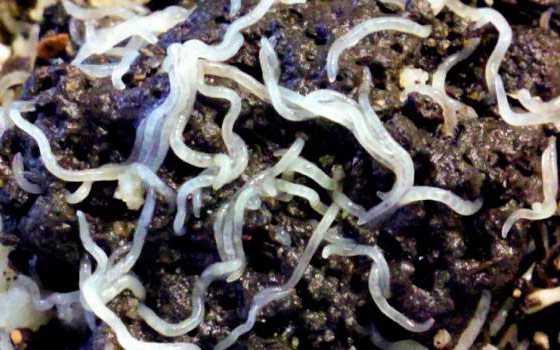

In addition to physical processes that affect the formation of white plaque, biological factors also affect the soil surface. One of them is fungal microflora. It is formed, again, from over-watering.
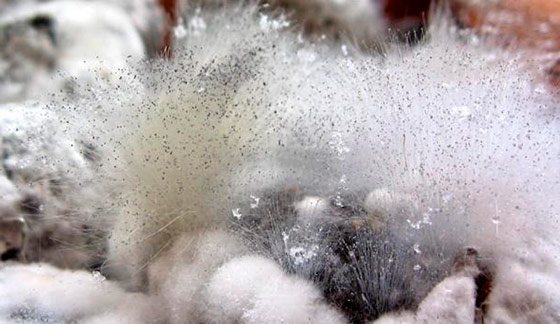

It happens that the acquired land already contains mold. For adult indoor flowers, this is not as dangerous as for young seedlings. Sometimes this mold grows all over the depth of the pot. I get rid of such a substrate as quickly as possible. And do not throw it into the garden! Somewhere away under the fence.
Indoor plants, garden flowers, vegetable growing, garden maintenance
- 5-11-2018, 05:54
- 7928
Mold and white plaque in indoor plant pots. How to get rid of?
When caring for indoor plants, we often notice that mold or white bloom appears on the surface of the earth.... What causes mold in indoor flower pots and how to get rid of it is described in this article.
The appearance of mold on the ground is a threat to the health of an indoor flower in a pot, since mold can spread to the stem and cause rotting of the roots.
On the surface of the soil, there is mainly white mold, similar to white fluff. It is a type of mold that spreads in the upper layer of the earth. This fungus is widespread and often grows in flower pots under favorable conditions.
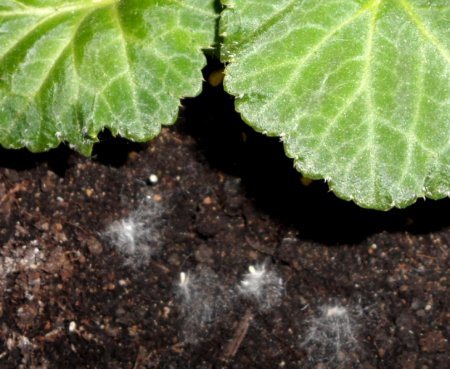

White bloom or efflorescence are crystals of soluble salts that have come out , they appear on the surface of the earth, on the walls of the pot, on the base of the plant, they can be white, yellow or brown. The appearance of a white bloom signals a deterioration in the quality of the soil in the pot, since the roots are in unfavorable conditions, they can rot.
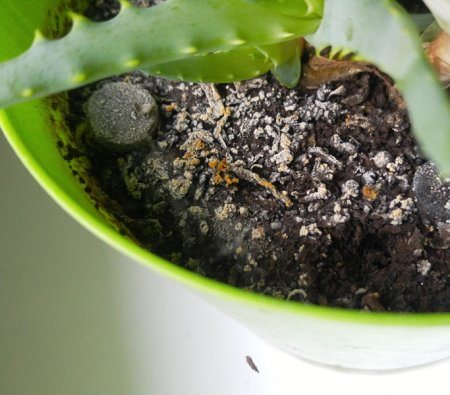

Why is there mold or white deposits in flower pots?
First of all, mold in a pot appears due to mistakes in caring for a houseplant:
- Mold causes over-watering ... Many growers are afraid to dry their indoor flowers and water them often and abundantly. In permanently damp ground, mold grows rapidly.Water indoor flowers after checking the soil, its top layer should dry 2-3 cm before the next watering, then there will be no mold.
- Another mistake is watering little by little, but often so that only the top soil in the pot gets wet. Consequently, the roots do not get moisture at depth, the plant looks dry, and mold grows on the surface of the earth and efflorescence appears.
You need to water the indoor plant correctly with small portions of water several times with an interval of 5 minutes until water appears from the drainage holes, which means that the clod of earth is completely saturated with moisture and you can take a long break before the next watering.
Potted soil decoration
When decorating the ground in a flower pot, then in most cases fine gravel is used, which is painted with multi-colored dyes.
Painted stones are washed with water and poured into a lump in a flower pot with a layer of up to 2 cm. If desired, patterns, drawings or ornaments are made of colored stones. The main thing is to show imagination and use stones of different sizes for mulching, ranging from 2-3 mm and ending with large specimens up to 1 cm.
Fine orange gravel or coarse colored sand, which can be bought at a flower shop, is also used to decorate the top layer of the soil.
Usually soil is decorated for different sized cacti in landscaping. Group plantings of succulents of different varieties, which are decorated with multi-colored pebbles, look very impressive. You can also use sea, small pebbles, pebbles for decoration. For plants that need high moisture, sphagnum moss is used, which makes the surface of the soil a rich green color. If the moss has lost its useful properties, then its top layer turns brown. In this case, it is replaced with new moss. A lot of useful information in the article: DIY garden and indoor flower stand from various materials.
The best DIY flower mixes
Ready-made potting mixes are not able to fully meet the needs of indoor plants. Experienced growers prefer to compose the soil on their own, taking into account the characteristics of the flower.
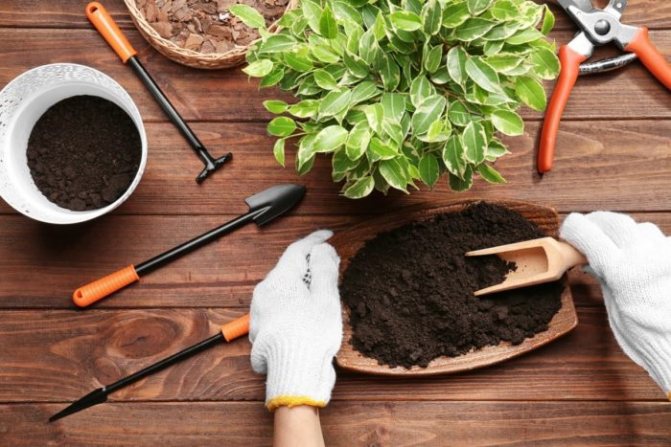

The basis of the homemade mixture is peat, to which the following components are added in different proportions:
- sod land;
- humus;
- charcoal;
- sphagnum moss;
- coconut chips or shavings;
- vermiculite;
- river sand;
- perlite;
- needles.
Prepare the components of the potting mix on their own or purchase the necessary components in the store. When preparing, wear rubber gloves and mix the elements with a spatula or by hand. Then the soil is clamped and unclenched in the palm of your hand, and its condition is assessed. It should not be too loose, but not stick together into a lump.
Prevention of the earth against white plaque (mold)
Fighting a fungus in a flower pot is not always easy, it takes more than one day, it happens that a week is not enough. Therefore, it is always easier to prevent infection than to cure it later.
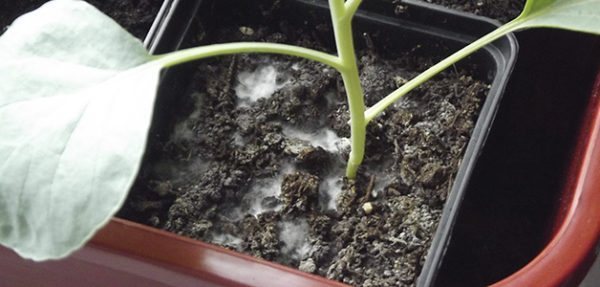

Preventive measures:
- Constant loosening of the soil, especially after watering. This will provide additional air intake and evaporation of excess moisture.
- Providing good and reliable drainage. This is one of the main conditions for planting a flower. It is important that it allows water to pass through well.
- The correct selection of pots or pot. The planter must be selected depending on the shape and location of the roots.
- Feed regularly. Good quality fertilizers will help the plant withstand stress.
- Monthly treatment with a weak solution of potassium manganese. Potassium permanganate will disinfect the soil.
- Ventilation of premises. Plants need daily airing of the room, but this does not mean at all that it is necessary to arrange drafts.
- Creation of an optimal level of humidity.
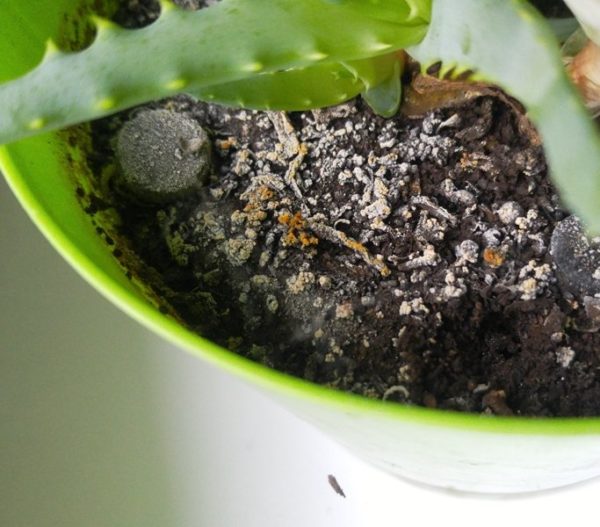

By following simple and simple tips, you can prevent the appearance of white bloom and fungi such as mold.
What ready-made mixtures are suitable?
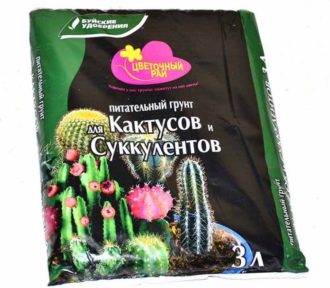

In a specialized store for planting a Decembrist, sellers will offer a substrate intended for cacti, or universal. Despite the fact that the Christmas tree is a cactus, a nutrient-poor substrate for succulents, it will not work, unlike the universal one. But nevertheless, the soil for cacti has a number of characteristics that are important for the full development of Schlumberger:
- looseness;
- air and moisture permeability;
- the required level of acidity.
therefore professionals recommend mixing in a 1: 1 ratio the two above types of purchased substrate.
When choosing a soil, it is necessary to pay attention to the shelf life of the substrate, its composition, physical characteristics: normal moisture level, fibrous content, the presence of loosening components.
Fertilizer oversaturation
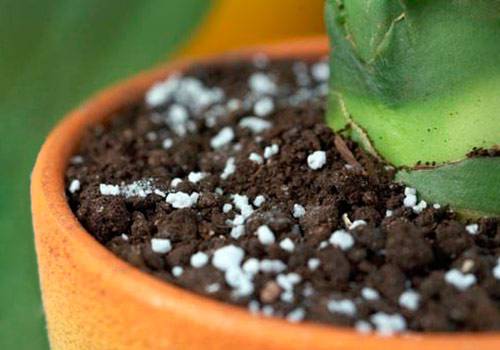

White bloom on the soil forms if the houseplant is overfed with fertilizers. Once I bought a substrate in the store and over time I discovered that the soil in the pot began to be covered with a white coating. It turned out that I had purchased soil intended for planting vegetables. Manufacturers usually oversaturate such mixtures with fertilizers.
Improper plant nutrition can also disturb the condition of the soil. During the growth period, it is important to accurately calculate the dosage. During dormancy, I do not fertilize the houseplants at all.
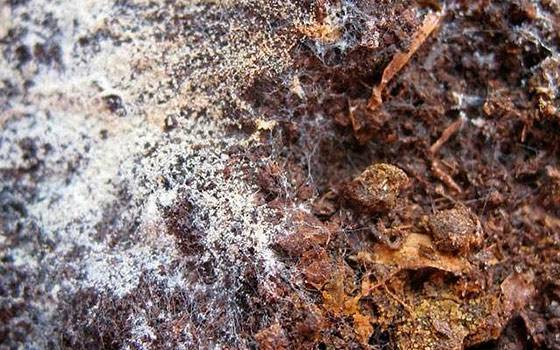

Plaque can also be caused by too much soil that does not match the size of the plant and its needs. The roots will not fully absorb moisture, and its excess will begin to form salt deposits when it comes to the surface. Therefore, I always select a pot according to the size of each particular plant. The soil in the pot is also covered with a white bloom from too soft water.
Soil requirements for succulents
The three main conditions that the soil for growing succulents must meet are a light, loose structure, good aeration and excellent drainage. Acidity and nutrient availability are not so important. Although, of course, succulents also do not like strongly acidic soil and bloom well only with a sufficient amount of mineral elements in it. An important point is that it is categorically not recommended to apply humus, for example, or nitrogen fertilizers in pure form. As a rule, succulents grow very slowly, and an excess of nitrogen, provoking increased growth, leads to the fact that the outer skin is cracked and the plant is covered with ugly scars.
To increase looseness and aeration, it will not hurt to add coarse sand, pebbles or brick chips to some ready-made purchased soils. Indeed, many of the succulents naturally grow on stones or in crevices of rocks. The drainage of the soil mixture should be such as to exclude even short-term waterlogging. The earthen lump should be quickly saturated with moisture and also dry quickly so that the root system does not rot.
Waterlogging of the soil
White bloom on the soil of indoor plants is formed for various reasons.
- Improper watering is one of the main ones. Water, which is supplied to the plant in excess, begins to actively evaporate, forming salt on the surface of the soil.
- Their accumulation also occurs in the case of poor watering. In this case, only the upper layer of the substrate is impregnated with water. I water the plants so that the water passes through the entire soil, but does not stay in it. For this I create a good drainage layer. It allows excess water to leave after irrigation and not evaporate on the soil surface.
- Dry room air also leads to intense evaporation of water, and salts are quickly carried to the topsoil. It gradually becomes salty, and this plant starts to hurt.Now I constantly monitor the humidity of the air and noticed that the salt crust has ceased to form.
Reproduction
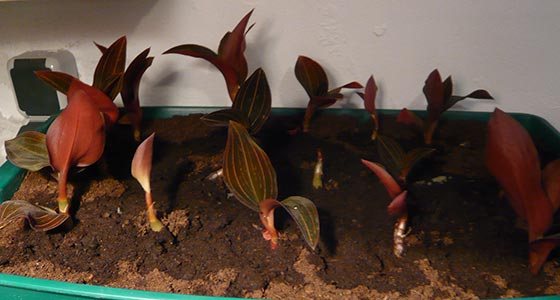

- The easiest way to propagate ludisia is cuttings. To do this, cut off the top of the stem and place it in a glass of clean water. After a few days, a root panicle is formed at the end of the cutting, after which the sprout can be planted in the soil.
- You can just as quickly propagate hemaria with a stem. To do this, place a pot of soil next to the flower, press one stem to its surface, fix it and lightly sprinkle the place of contact with the ground. Soon a sprout will appear in this place, you can release the stem.
Now decide what kind of soil to plant the plant in.
Signs of a mealybug infection
To detect pests, it is enough to carefully examine the houseplant.
The main signs are:
- drooping appearance, lethargy of leaves and shoots;
- underdeveloped buds, deformed leaves;
- white powdery bloom with lumps;
- small "mosquitoes" (male worms) on the windows near the pots;
- the presence of sticky mucus (honeydew) on all parts of the plant;
- the presence of white blotches in an earthen coma during transplantation;
- the presence of white oval insects.
Any of these symptoms may indicate the appearance of a worm. Not a single flower is immune to infection. For special control, you need to take citrus, amaryllid, cycad and palm plants, as well as cacti, violets and orchids.
Often suffers from an azalea pest, a photo of which is given in the article. The pest attacks young shoots. The leaves stop growing and begin to turn yellow. Azalea, a photo of which demonstrates its beauty, affected by insects, is losing its former appearance.
Preventive measures
- Periodically inspect the green spaces carefully.
- Transplant grown flowers regularly.
- Inspect the earthen lump when transplanting. Flush the primer with hot water (approx. 55 ° C).
- Properly care for flowers according to their preferences.
- Remove dying parts of the plant in a timely manner. Dried leaves can serve as a convenient shelter for various pests.
- Before planting, scald the pots with boiling water, and steam the soil.
- Observe quarantine measures for new plants.
Insects are an integral part of any ecosystem, but they have no place on the green window sills of apartments. Especially if a mealybug has appeared on indoor plants. You know how to deal with a pest. Therefore, use whatever methods are available. After all, healthy indoor plants without pests are actively developing and delight the eye with bright greenery and abundant flowering.
Prophylaxis
We will find out what measures will help to avoid the appearance of a whitish bloom in a flowerpot with flowers, we will find out.
- First, you should be careful about watering. You do not need to moisten the flower if the top layer of the earth has not yet dried out. Such excessive watering of plants leads to waterlogging of the soil, stagnation and various negative consequences.
- If the water is hard, it can be softened by adding a small amount of lemon acid (half a teaspoon per liter). If there is no acid, be sure to settle the tap water for about a day before watering.
- The pot must be chosen the most suitable for the size of the plant. Too large flowerpots and pots are undesirable to use, however, as well as overly tight.
- Provide good drainage for the flower. Below, under the ground, it is advisable to lay a small layer of expanded clay. Choose a pot only with drainage holes - otherwise, stagnation in the soil is very likely. Consequently, mold, fungus and other negative signs of waterlogging will appear.
- Loosen the soil regularly to make the soil more permeable.
- In order to prevent the formation of plaque, it is recommended to do disinfection by watering the ground with potassium permanganate once a month.
- Remember to regularly ventilate the room where the plant is located.
- Use high-quality soil, preferably ready-made, from the store. Look carefully at the composition and purpose of the soil when purchasing.
- Use expanded clay, sand or charcoal as a mulch layer.
We found out why white bloom appears in the flower pot. There are several reasons and most of them are somehow connected with improper agricultural technology. By starting to care for the plant properly and providing it with the necessary conditions, you can avoid the appearance of white bloom and grow a healthy, beautiful flower.
Harm to the plant
The mealybug literally draws out all the nutrients from the flowers, disrupting their growth and normal development. Sweet honeydew secreted by females provokes the development of associated fungal infections. Due to the sticky impervious coating, the breath of the green pet is impaired. This can lead to wilting and even leaf fall.
Mealy aphids (another name for worms) do not give preference to a certain part of the plant, affecting everything that occurs in its path. Not only shoots, buds and leaves are under attack, but also the roots. If you do not start treatment as soon as possible, the worm will spread to the surrounding indoor plantings. In time, he will destroy them all. Therefore, you must immediately declare war if you notice mealybugs on indoor plants. How to deal with a pest will be described below.
Ready soil for succulents
When buying ready-made soil intended for succulents, you should especially carefully study its composition. Indeed, this group includes quite a few plant species - with different preferences and requirements for soil conditions. And for manufacturers, the composition of soils may also differ. An indispensable component of most store-bought substrates is peat. It has a high acidity, which is usually reduced by the addition of ground limestone or dolomite flour.
Peat itself is also different:
Horse - light, practically does not contain any nutrients, it is bad that it retains moisture for a long time, and after drying it is very difficult to wet.
Lowland - heavy and cakes quickly. Therefore, baking powder of natural and artificial origin is added to peat and peat mixtures, most often sand and crushed expanded clay.
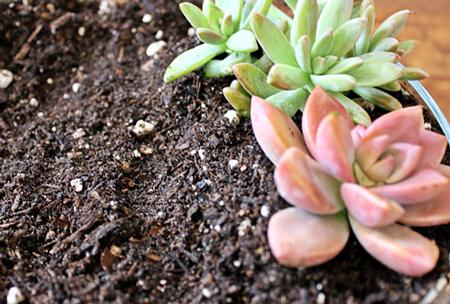

There are also special nutritious soils on sale that contain suitable fertilizers. For example, ready-made soils for succulents from Seliger-Agro and Biagro (LLC Bikey). The main component of the substrates from these producers is a mixture of high and low peat. As part of the soil under the brand name "Bereginya" (LLC "Fasco") compost is added to the high peat. offers ready-made soil for growing cacti, which includes vermicompost.
Mold - what is it
This is a microscopic fungus, consisting of branching filaments - hyphae. Most often, these fungi reproduce by spores. There are many of them in the air around us, they are in the soil and on various objects. Mold feeds on organic residues. The best conditions for its development are warm and high air humidity.
Mold is surprisingly tenacious. She was found in space and on the walls of a nuclear reactor at Chernobyl. She is not afraid of frost, so freezing the soil does not rid it of fungal spores. It is extremely difficult to fight mold fungi; it is best simply not to create optimal conditions for their existence and development.
Mealybug chemicals
With the ineffectiveness of folk methods or large foci of infection, one has to turn to chemical insecticides.
Effective mealybug drugs are widely available:
- "Decis".
- Vertimek.
- Tsvetofos.
- Nurell D.
- Phosphamide.
- Bi-58.
- Actellik.
- Fitoverm.
- Apploud.
There should not be any particular difficulties with such substances. The main thing is to carefully read the instructions and follow all safety precautions.
Affected plants should be quarantined. Usually 3-4 insecticide treatments are sufficient. If the pests still remain, you need to change the drug.
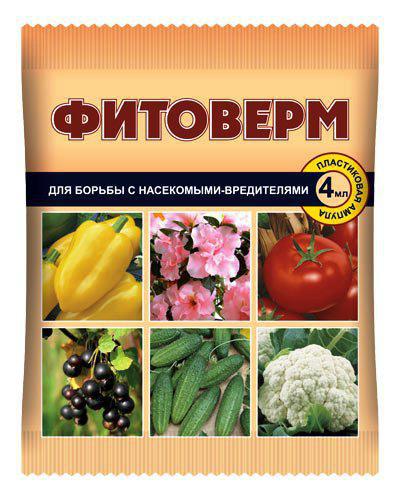

Why is she dangerous
Penetrating into the respiratory tract of a person, it settles in the lungs. Mold accumulates in the body and causes various diseases, including allergies and toxic poisoning. Mold is especially dangerous for people with low immunity.
It negatively affects plants:
- mold is a fungus, followed by more aggressive fungal races, from which the roots of seedlings can rot, possibly a black leg disease;
- plant nutrition is disrupted, mold waste products have an acidic reaction, therefore, they change the acid-base balance of the soil for the worse for plants;
- oxygen is poorly supplied to them;
- their immunity decreases and tissue regeneration worsens.
Most of all, mold is dangerous for small seedlings that have not yet been dived. The adult seedlings have already mastered the entire volume of the pot, its root system secretes substances that suppress the growth of molds, and the gardener will have to take care of the "kids".
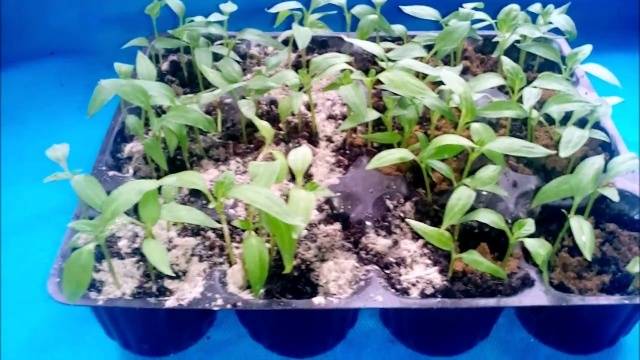

Seedling crops are grown indoors. It would seem that in a confined space nothing bad can happen to them, there is no contact with the street, and molds simply have nowhere to come from. Why does the soil become moldy in seedlings?
How to prepare the soil yourself?
For adult plants
- Prepare all the necessary components, which should be in different containers: 6 parts of leafy soil, 1 part of sod land, 4 parts of humus soil, 2 parts of peat, 2 parts of sand, a little perlite or other baking powder (no more than 10% of the total).
- Prepare a large container in which all the ingredients will be mixed.
- Prepare a measuring container, spatula, gloves.
- Wearing gloves on your hands, you should measure the required volumes of all constituents of the substrate.
- After pouring all the ingredients into a large container, mix them thoroughly with a spatula.
- Pour the soil onto a baking sheet up to 5 cm thick and moisten.
- The baking sheet should be placed in an oven preheated to + 70C - + 90C. The duration of calcination is at least 30 minutes.
For a young Christmas
For young plants, the soil should be lighter and more loose, therefore, the percentage of baking powder should be higher than for mature plants with a powerful root system.
- Prepare everything you need to prepare the mixture: a large container, a spatula, gloves, a measuring container.
- After pre-drying all the ingredients, place them in different containers.
- Put gloves on your hands.
- Pour into a large container 2 parts of compost soil, 1 part of river sand, 2 parts of peat, 3% each of fresh sawdust, tree bark, perlite, vermiculite, sphagnum. Mix everything well.
- Pour the resulting substrate into a fine-mesh colander and spill with a fungicide solution or a bright pink solution of potassium permanganate.
